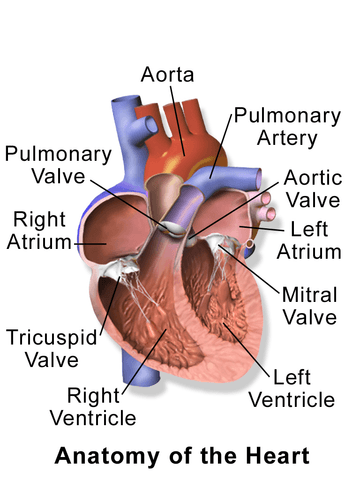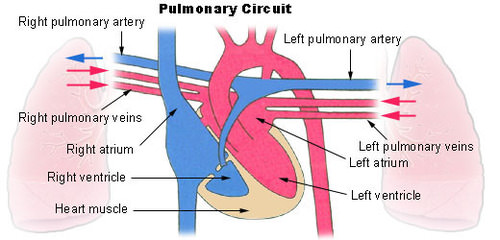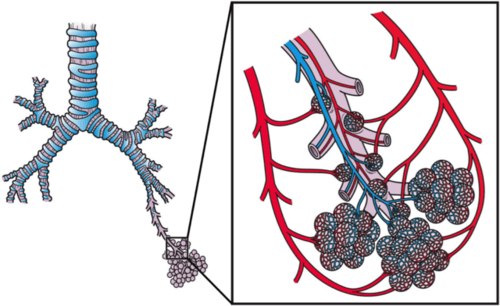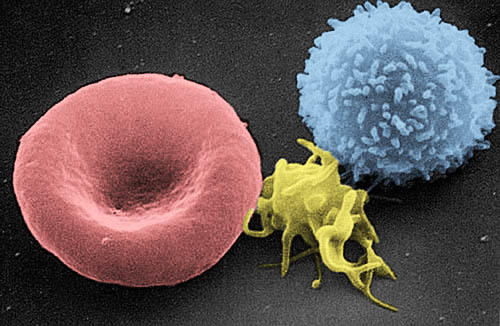16.2 心血管系统介绍
Section outline
-
Ant Hill or Plumbing System?
::蚂蚁山还是管道系统?What do you think this picture shows? Is it a maze of underground passageways in an ant hill? A network of interconnected pipes in a complex plumbing system? The picture actually shows something that, like ant tunnels and plumbing pipes, functions as a transportation system. It shows a network of , which are part of the cardiovascular system.
::你认为这幅图显示什么?它是一个蚂蚁山地下通道迷宫吗?一个复杂的管道系统中连接管道的网络?这幅图实际上显示了一些东西,像蚂蚁隧道和管道管道一样,作为运输系统发挥作用。它显示了一个网络,是心血管系统的一部分。What is the Cardiovascular System?
::什么是心血管系统?The cardiovascular system , also called the , is the organ system that transports materials to and from all the of the body. The materials carried by the cardiovascular system include oxygen from the lungs , nutrients from the , from glands of the , and waste materials from cells throughout the body. Transport of these and many other materials is necessary to maintain of the body. The main components of the c ardiovascular system are the heart, blood vessels, and . Each of these components is shown in the following and introduced below.
::心血管系统,也称为心血管系统,是将材料运入和运出所有身体的器官系统,心血管系统携带的材料包括肺部的氧气、肺部的营养素、腺部的营养素,以及整个身体细胞的废物材料,这些和许多其他材料的运输对于身体的保持是必要的,心血管系统的主要组成部分是心脏、血管和。这些组成部分的每个部分在下文和下文中说明。This simplified drawing of the cardiovascular system shows its main structures. The heart is shown in the chest in red. Blood vessels called arteries are also shown in red, and blood vessels called veins are shown in blue.
::心血管系统的简化图示显示了它的主要结构。心脏在胸前以红色显示,血管血管也以红色显示,血管以蓝色显示。Heart
::心心心The heart is a muscular organ in the chest. It consists mainly of cardiac muscle tissue , and it pumps blood through blood vessels by repeated, rhythmic contractions. As shown in the figure , the heart has four inner chambers: a right atrium and ventricle , and a left atrium and ventricle. On each side of the heart, blood is pumped from the atrium to the ventricle below it, and from the ventricle out of the heart. The heart also contains several valves that allow blood to flow only in the proper direction through the heart.
::心脏是胸部的肌肉器官,主要由心脏肌肉组织组成,通过反复的、有节奏的收缩通过血管抽取血液。如图所示,心脏有四个内部:右中庭和心室,左中庭和心室。在心脏的两侧,血液都从心部抽动到下部的心室,从心脏的心室抽动。心脏中也包含若干阀门,允许血液流向正确的心脏方向。The right side of the heart includes the right atrium and right ventricle. The left side includes the left atrium and left ventricle.
::心脏右侧包括右中庭和右心室,左侧包括左中庭和左心室。Unlike , cardiac muscle routinely contracts without stimulation by the . Specialized cardiac muscle cells send out electrical impulses that stimulate the contractions. As a result, the atria and ventricles normally contract with just the right timing to keep blood pumping efficiently through the heart.
::与心脏肌肉不同的是,心脏肌肉经常在不受心脏刺激的情况下发生接触。 专门的心脏肌肉细胞会发出刺激收缩的电脉冲。 结果,腹部和腹部通常会与保持血液有效流过心脏的适当时机相连接。Blood Vessels
::鲜血船The blood vessels of the cardiovascular system are like a network of interconnected, one-way roads that range from superhighways to back alleys. Like a network of roads, the blood vessels are tasked with allowing the transport of materials from one place to another. There are three major types of blood vessels: arteries , veins , and capillaries. They are illustrated in the figure and described below.
::心血管系统的血管血管像一个连接的单行公路网络,从超高道到后巷,如公路网,血管血管负责将材料从一个地方运到另一个地方,有三种主要类型的血管:动脉、血管和血管。This diagram represents the structure and functions of the different types of blood vessels in the cardiovascular system.
::该图显示心血管系统中不同类型血管的结构和功能。-
Arteries
are blood vessels that carry blood away from the heart (except for the arteries that actually supply blood to the heart muscle). Most arteries carry oxygen-rich blood, and one of their main functions is distributing oxygen to tissues throughout the body. The smallest arteries are called arterioles.
::大多数动脉都含有含氧丰富的血液,其主要功能之一是将氧分解到整个身体的组织中。 最小的动脉被称为动脉。 -
Veins
are blood vessels that carry blood toward the heart. Most veins carry deoxygenated blood. The smallest veins are called venules.
::血管是血流到心脏的血管,大部分血管是脱氧血液,最小的血管被称为静脉。 -
Capillaries
are the smallest blood vessels, and they connect arterioles and venules. As they pass through tissues, they exchange substances (including oxygen) with cells.
::Capillary是最小的血管,它们连接了动脉和静脉。随着它们通过组织,它们用细胞交换物质(包括氧气)。
Two Circulations
::两个环流Cells throughout the body need a constant supply of oxygen. They get oxygen from capillaries in the systemic circulation . The systemic circulation is just one of two interconnected circulations that make up the human cardiovascular system. The other circulation is the pulmonary system, which is where blood picks up oxygen to carry to cells. It takes blood about 20 seconds to make one complete transit through both circulations.
::整个身体的细胞需要恒定的氧气供应。 它们从系统循环中的刺青中获取氧气。 系统循环只是构成人类心血管系统的两个相互关联的循环中的一个。 另一个循环是肺系统, 血液将氧气输送到细胞中。 血液大约需要20秒才能完全通过两个循环。Pulmonary Circulation
::肺循环The pulmonary circulation involves only the heart, the lungs, and the major blood vessels that connect them, and it is illustrated in the figure . Blood moves through the pulmonary circulation from the heart, to the lungs, and then back to the heart again, becoming oxygenated in the process. Specifically, the right ventricle of the heart pumps deoxygenated blood into the right and left pulmonary arteries . These arteries carry the blood to the right and left lungs, respectively. Oxygenated blood then returns from the right and left lungs through the two right and two left pulmonary veins. All four pulmonary veins enter the left atrium of the heart.
::肺循环仅涉及心脏、肺和连接它们的主要血管,图中也说明了这一点。血液从心脏、肺和肺的肺循环中穿过肺循环,然后又回到心脏,在过程中氧化了。具体地说,心脏的右心室将脱氧血液泵入右侧和左肺动脉。这些动脉将血液分别输送到左侧和右肺。氧化血液从左侧和右侧的肺部通过右侧的和左侧的肺部返回。所有四个肺血管都进入心脏的左心室。This diagram shows the heart, lungs, and major vessels that make up the pulmonary circulation. The colored arrows indicate the direction of blood flow — red for oxygenated blood and blue for relatively deoxygenated blood.
::本图表显示了构成肺循环的心脏、肺和主要血管。 彩色箭头显示了血液流的方向 — — 红为氧化血液,蓝色为相对脱氧血液。What happens to the blood while it is in the lungs? It passes through increasingly smaller arteries, and finally through capillary networks surrounding the alveoli (see figure ). This is where gas exchange takes place. The deoxygenated blood in the capillaries picks up oxygen from the alveoli, and gives up carbon dioxide to the alveoli. As a result, the blood returning to the heart in the pulmonary veins is almost completely saturated with oxygen.
::血液在肺部时会怎样呢?它经过越来越小的动脉,最后又经过肺部周围的毛毛虫网络(见图 ) 。 这是发生气体交换的地方。 血管中的脱氧血液从肺部吸收氧气,将二氧化碳丢给肺部。 结果,血液返回肺部血管的心脏时几乎完全饱和了氧气。This diagram illustrates clusters of alveoli in the lungs, where gas exchange takes place with blood in capillaries as it passes through the pulmonary circulation.
::该图说明了肺部的alveoli群,在肺循环过程中,气流与血液在毛细血管中交换。Systemic Circulation
::系统循环The oxygenated blood that enters the left atrium of the heart in the pulmonary circulation then passes into the systemic circulation. This is the part of the cardiovascular system that transports blood to and from all of the tissues of the body to provide oxygen and nutrients, and to pick up wastes. It consists of the heart and blood vessels that supply the metabolic needs of all the cells in the body, including those of the heart and lungs.
::进入肺循环中心脏左心部的氧化血液,然后进入系统循环,这是心血管系统中将血液输送到身体所有组织,以提供氧气和养分,并收集废物的部分,由心脏和血管组成,满足身体中所有细胞,包括心脏和肺部细胞的代谢需要。As shown in the figure , in the systemic circulation, the left atrium pumps oxygenated blood to the left ventricle, which pumps the blood directly into the aorta , the body’s largest artery. Major arteries branching off the aorta carry the blood to the head and upper extremities. The aorta continues down through the abdomen and carries blood to the abdomen and lower extremities. The blood then returns to the heart through the network of increasingly larger veins of the systemic circulation. All of the returning blood eventually collects in the superior vena cava (upper body) and inferior vena cava (lower body), which empty directly into the right atrium of the heart.
::如图所示,在系统循环中,左中子泵氧化血液流到左心室,将血液直接抽进身体最大的动脉动脉,大动脉从动脉外切到头部和上部四肢。动脉继续穿过腹部,将血液输送到腹部和下部。然后血液通过系统循环中日益扩大的血管网络返回心脏。所有归回的血液最终都聚集在高端的Venacava(上部)和下部Venacava(下部)中,直接空入心脏右部。The systemic circulation includes the aorta (red), which carries oxygenated blood away from the heart to the rest of the body; and the inferior and superior venae cavae (blue), which return deoxygenated blood to the heart from the body. The colored arrows in the diagram indicate the direction of blood flow — red for oxygenated and blue for deoxygenated.
::系统循环包括动脉(红),它将氧化的血液从心脏运到身体的其余部分;以及下等和上等的阴茎(蓝),将脱氧血液从身体送回心脏,图中的彩色箭头显示血液流动的方向——红为氧,蓝色为脱氧。Blood
::血血血血血血血血血血血血血血血血血血血血血血血血血血血血血血血血血血血血血血血血血血血血血血血血血血血血血血血血血血血血血血血血血血血血血血血血血血血血血血血血血血血血血血血血血血血血血血血血血血血血血血血血血血血血血血血血血血血血血血血血血血血血血血血血血血血血血血血血血血血血血血血血血血血血血血血血血血血血血血血血血血血血血血血血血血血血血血血血血血血血血血血血血血血血血血血血血血血血血血血血血血血血血血血血血血血血血血血血血血血血血血血血血血血血血血血Blood is a fluid connective tissue that circulates throughout the body in blood vessels by the pumping action of the heart. Blood carries oxygen and nutrients to all the body’s cells, and it carries carbon dioxide and other wastes away from the cells to be excreted. Blood also transports many other substances, defends the body against infection, repairs , and controls the body’s pH, among other functions.
::血液是一种流体连接组织,通过心脏的抽动作用在血管中循环。 血液将氧气和养分带给身体的所有细胞,并将二氧化碳和其他废物从细胞中排泄出来。 血液还运送许多其他物质,保护身体不受感染,修复和控制身体的pH等功能。The fluid part of blood is called plasma . It is a yellowish, watery liquid that contains many dissolved substances and blood cells. Types of blood cells in plasma include red blood cells , white blood cells , and platelets , all of which are illustrated in the photomicrograph and described below.
::血液中的液体部分称为血浆,是一种黄色的、水状的液体,含有许多溶解物质和血细胞,血浆中的血细胞类型包括红血细胞、白血细胞和小板,所有这一切都在照片显像仪中作了说明,下文对此作了说明。The three types of cells in blood are pictured here: red blood cell (left), platelet (center), and white blood cell (right).
::这里描绘出三种血细胞:红血细胞(左)、小板(中)和白血细胞(右)。-
Red blood cells
have the main function of carrying oxygen in the blood. Red blood cells consist mostly of
hemoglobin
, a
containing iron that binds with oxygen.
::红血细胞的主要功能是携带血液中的氧气,红血细胞主要由血红蛋白组成,血红蛋白是一种含铁的铁,与氧结合。 -
White blood cells
are far fewer in number than red blood cells. They defend the body in various ways.
W
hite blood cells called
phagocytes
, for example, swallow and destroy
, dead cells, and other debris in the blood.
::白血细胞的数量远远少于红血细胞。白血细胞以各种方式保护身体。白血细胞被称为发细胞,比如吞咽和摧毁、死亡细胞和血液中的其他残块。 -
Platelets
are cell fragments involved in blood clotting. They stick to tears in blood vessels and to each other, forming a plug at the site of injury. They also release chemicals that are needed for clotting to occur.
::血凝块是血凝结中涉及的细胞碎片,它们坚持在血管中流泪,彼此相互残缺,在受伤地点形成塞子,还释放了凝凝结所需的化学品。
Summary
::摘要-
The cardiovascular system is the organ system that transports materials to and from all the cells of the body. The main components of the cardiovascular system are the heart, blood vessels, and blood.
::心血管系统是将材料从身体所有细胞运入和运出身体的所有细胞的器官系统,心血管系统的主要组成部分是心脏、血管和血液。 -
The heart is a muscular organ in the chest that consists mainly of cardiac muscle and pumps blood through blood vessels by repeated, rhythmic contractions. The heart has four chambers through which blood flows, and valves that keep blood flowing in just one direction.
::心脏是胸口的肌肉器官,主要由心脏肌肉组成,通过血管通过反复的、有节奏的收缩抽取血液。 心脏有四个呼吸室,血液流动和阀门将血液流向一个方向。 -
Blood vessels carry blood throughout the body. Major types of blood vessels are arteries (which mainly carry blood away from the heart), veins (which carry blood toward the heart), and capillaries (which exchange substances between the blood and cells of the body).
::主要类型的血管是动脉(主要从心脏取出血液)、血管(向心脏流出血液)和血管(在身体血液和细胞之间交换物质)。 -
The cardiovascular system has two interconnected circulations. The pulmonary circulation carries blood between the heart and lungs, where blood is oxygenated. The systemic circulation carries blood between the heart and the rest of the body, where it delivers oxygen.
::心血管系统有两种相互关联的循环。肺循环在血液供氧的心脏和肺之间传播血液。系统循环在心脏和身体其他部分之间传播血液,在其中提供氧气。 -
Blood is a fluid connective tissue that circulates throughout the body in blood vessels. It consists of a liquid part — called plasma — which contains many dissolved substances, and cells, including red blood cells, white blood cells, and platelets.
::血液是一种流体连接组织,通过血管在全身循环,由液体部分组成,称为等离子体,含有许多溶解物质和细胞,包括红血细胞、白血细胞和小板。
Review
::回顾1. What is the cardiovascular system? What are its main components?
::1. 什么是心血管系统?其主要组成部分是什么?2. Describe the heart and how it functions.
::2. 描述心脏及其功能。3. List the three major types of blood vessels and their basic functions.
::3. 列出三种主要类型的血管及其基本功能。4. Compare and contrast the pulmonary and systemic circulations.
::4. 比较和对比肺循环和系统循环。5. What is blood? What are its chief constituents?
::5. 什么是血?它的主要选民是什么?6. True or False: The circulatory system brings blood to and from the body, while the cardiovascular system brings blood to and from the lungs only.
::6. 真实的或假的:循环系统从身体中产生血液,而心血管系统只从肺中产生血液。7. True or False: Arteries carry mainly oxygenated blood.
::7. 真实或虚假:动脉主要含有氧化血液。8. Name three different types of substances transported by the cardiovascular system.
::8. 列出心血管系统运输的三种不同类型的物质。9. Describe where and how the pulmonary and systemic circulation systems meet.
::9. 说明肺循环系统和系统循环系统在何处和如何运行。10. Which of the following carries blood to the lungs? Choose all that apply.
::10. 下列哪些人携带血液进入肺部?a. left pulmonary artery
::a. 左肺动脉b. left pulmonary vein
::b. 左肺静脉c. right pulmonary artery
::c. 右肺动脉d. right pulmonary vein
::d. 右肺血管11. Put the following structures in order of how blood flows from the heart out to the body and back again:
::11. 将以下结构排列为血液如何从心脏流到身体和回流:capillaries; venules; aorta; veins; arteries
::心血管; 发泡管; 动脉; 血管; 动脉12. Explain why the heart and lungs need blood from the systemic circulation.
::12. 解释为何心脏和肺部需要系统循环血液。13. Do blood vessels carrying deoxygenated blood from the body back to the heart get increasingly larger or smaller?
::13. 携带从身体到心脏的脱氧血液的血管是否越来越大或越来越小?14. Blood becomes oxygenated in the lungs through gas exchange into ________________.
::14. 血液通过将气体转换为...而使肺部氧化。a. arterioles
::a. 动脉b. capillaries
::b. 毛膜c. venules
::c. 输卵管d. bronchioles
::d.支气管15. Which type of blood cell carries oxygen?
::15. 哪种血细胞携带氧气?Explore More
::探索更多Watch this fast-paced CrashCourse video to explore how the cardiovascular and respiratory systems work together to deliver oxygen and remove carbon dioxide from cells.
::探索心血管和呼吸系统如何合作, 以提供氧气, 从细胞中去除二氧化碳。Check out this video to learn more about how the heart pumps blood.
::看看这段视频,了解更多心脏是如何抽血的。 -
Arteries
are blood vessels that carry blood away from the heart (except for the arteries that actually supply blood to the heart muscle). Most arteries carry oxygen-rich blood, and one of their main functions is distributing oxygen to tissues throughout the body. The smallest arteries are called arterioles.







